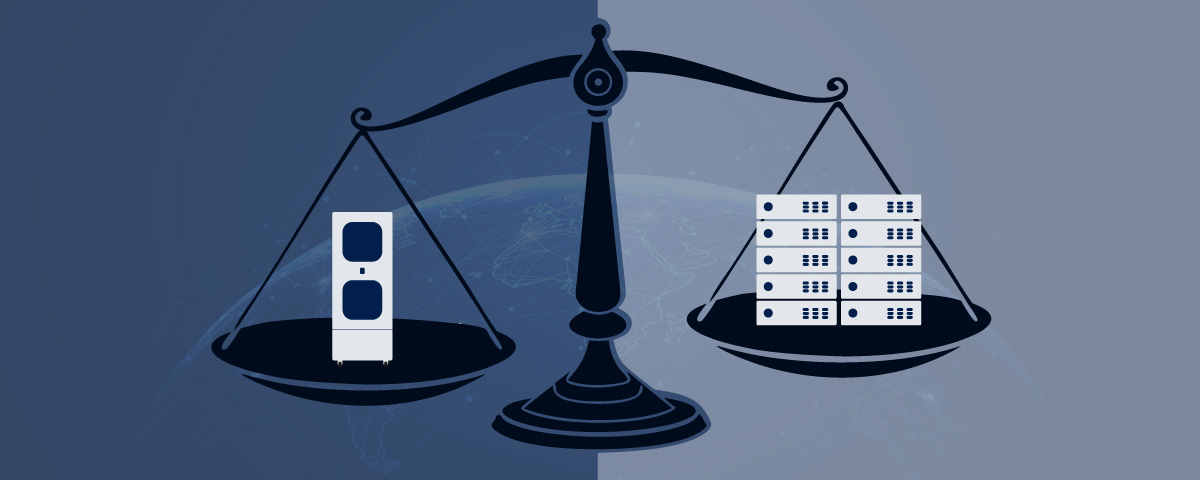The demand for efficient data management and storage solutions has never been higher. Traditional data centres, while powerful, often come with significant energy consumption and operational costs. Micro data centres provide a compact, efficient, and scalable alternative that offers substantial energy efficiency benefits. In this blog we’ll discuss how these innovative solutions are revolutionising energy efficiency in data management.
Understanding micro data centres
Micro data centres are small, self-contained units that offer all the functionality of traditional data centres but on a much smaller scale. They are designed to support edge computing applications by bringing data processing and storage closer to the source of data generation. This proximity not only reduces latency but also enhances overall efficiency.
How micro data centres reduce energy consumption
Reduced energy consumption
One of the primary advantages of micro data centres is their ability to significantly reduce energy consumption. Traditional data centres often require large amounts of power for both computing operations and cooling systems. In contrast, micro data centres are designed to operate with minimal energy input, utilising advanced cooling techniques and energy-efficient components. This reduction in energy consumption translates to lower operational costs and a smaller carbon footprint.
Efficient cooling systems
Cooling is a major energy drain in traditional data centres. Micro data centres, however, employ innovative cooling solutions that are far more efficient than traditional data centre cooling systems, ensuring that only the necessary components are cooled. Additionally, micro data centres often incorporate advanced airflow management systems that optimise the cooling process, further enhancing energy efficiency.
Scalability and modular design
The modular nature of micro data centres allows for scalability without the need for extensive infrastructure investments. This means businesses can add or remove capacity as needed, ensuring they are only using the energy required for their current needs. This adaptability not only improves energy efficiency but also reduces waste associated with over-provisioning.
Optimised Power Usage Effectiveness (PUE)
Power Usage Effectiveness (PUE) is a key metric used to measure the energy efficiency of data centres. A PUE ratio is calculated by dividing the total amount of energy used by the data centre by the energy used by the IT equipment alone. Micro data centres typically boast much lower PUE ratios compared to traditional data centres, indicating more efficient use of energy. This optimisation is achieved through advanced power management systems and the use of energy-efficient hardware.
Integration with renewable energy sources
Micro data centres are well-suited for integration with renewable energy sources such as solar or wind power. Their compact size and lower energy requirements make it feasible to power them with on-site renewable energy installations. This not only enhances energy efficiency but also aligns with sustainability goals, reducing reliance on fossil fuels and decreasing greenhouse gas emissions.
Edge computing benefits
By bringing data processing closer to the edge, micro data centres reduce the need for data to travel long distances to centralised data centres. This proximity reduces latency and the energy costs associated with data transmission. Additionally, edge computing can alleviate network congestion, leading to more efficient data flow and reduced energy consumption across the network.
Micro data centres real-world applications
Several industries are already reaping the benefits of micro data centres’ energy efficiency.
Healthcare
Hospitals and clinics are deploying micro data centres to manage patient data locally, reducing latency and improving response times. The energy-efficient design of these centres ensures that critical applications run smoothly without excessive power consumption (see how micro data centres support healthcare).
Telecommunications
Telecom companies are using micro data centres to support 5G networks and edge computing applications. These centres provide the necessary infrastructure for high-speed data processing while minimising energy usage (see how micro data centres support telecommunications).
Manufacturing
Smart factories are utilising micro data centres to process data from IoT devices and sensors in real-time. This local processing capability enhances operational efficiency and reduces the energy costs associated with data transmission to centralised data centres (see how micro data centres support manufacturing).
Zella DC’s commitment to energy efficiency
At Zella DC, we are dedicated to developing micro data centres that set new standards for energy efficiency. Our solutions incorporate cutting-edge technologies and sustainable practices to ensure that our clients can achieve their data management goals without compromising on energy consumption. From our advanced cooling systems to our integration with renewable energy sources, every aspect of our micro data centres is designed with efficiency in mind.
The shift towards micro data centres represents a significant step forward in the quest for energy-efficient data management solutions. By reducing energy consumption, optimising cooling systems, and integrating with renewable energy sources, micro data centres offer a sustainable alternative to traditional data centres. As businesses continue to prioritise efficiency and sustainability, micro data centres will play a crucial role in shaping the future of data management.
Key takeaways
- Micro data centres cut energy consumption and cooling costs.
- Lower PUE ratios mean better efficiency than traditional server rooms.
- Compact size makes renewable energy integration feasible.
- Industries like healthcare, telecom, and manufacturing already benefit.





